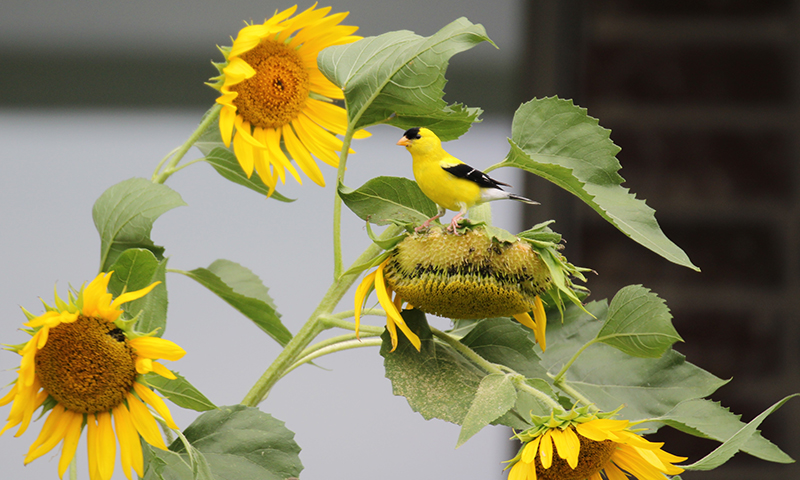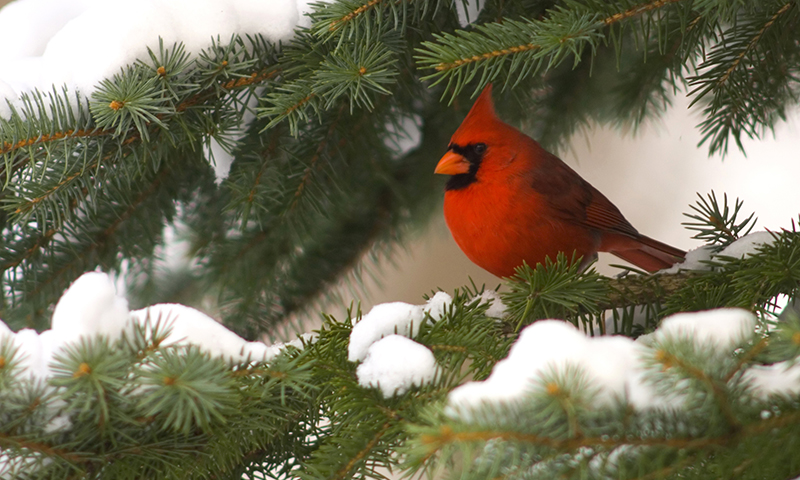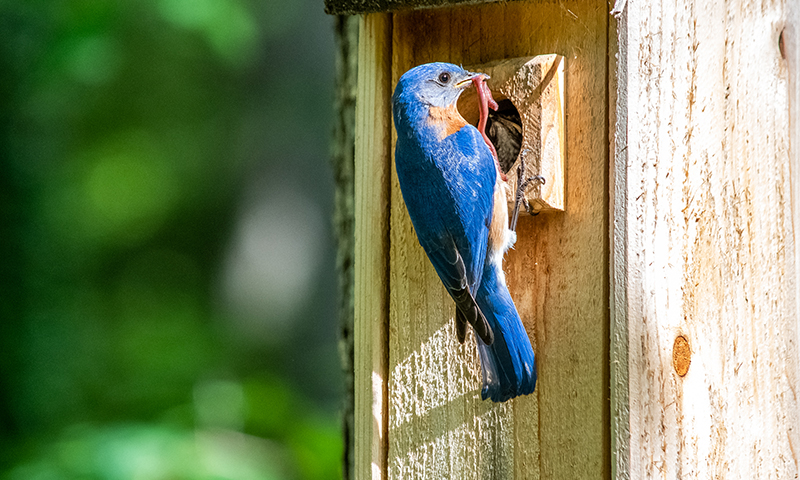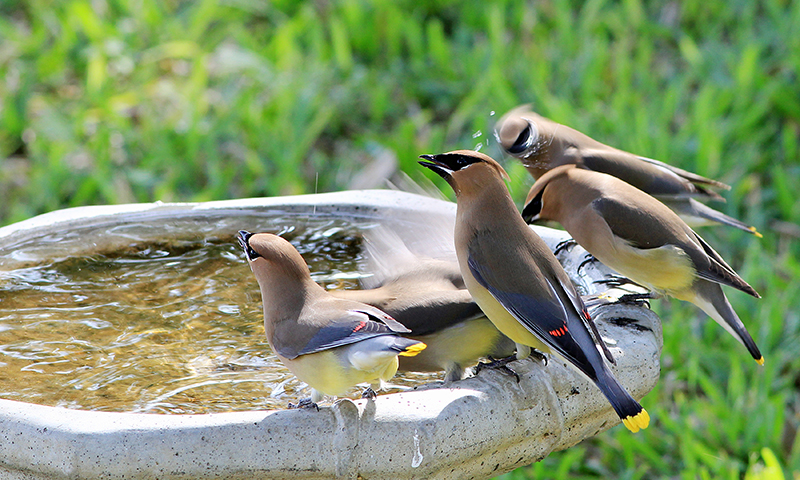How to Attract Wild Birds to Your Garden
Waking up to a songbird's early morning melody is a pretty great way to start the day — and it certainly beats an alarm. But that's only one of the benefits you'll enjoy when you invite wild birds to become part of your daily garden life.
By working in harmony with Mother Nature to attract wild birds, you help nurture biodiversity and enhance the environment at large. You can let birds know they're welcome and provide the essentials they need to thrive, all from your own slice of earth.
- Food Sources for Wild Birds
- Shelter to Keep Wild Birds Safe
- Next Generation Nesting Spots
- Wild Bird Water Features

Plants provide flowers for you and food for birds.
Food Sources for Wild Birds
The No. 1 item on your wild bird checklist is providing food to keep them nourished year-round. As birds migrate, the winged guests in your garden will change with the seasons. But food remains a priority, no matter who stops by. To keep nutrition rolling in a four-season bird garden, follow nature's lead with plants and nutritious seeds.
By birdscaping with native plants and other pollinator plants, you can provide nectar (and insects) for birds early in the year, fruit in summer and seeds as the season closes. With Pennington Rejuvenate Plant Food Rose & Flower 4-6-3, your flowering, seed-bearing plants will have bigger, better blooms. Who can resist gorgeous, easy-to-grow sunflowers like our Pennington Organic Classic Gold Sunflower Plant Seeds? Not birds or you! Same goes for your own wildflower meadow, an unmistakable invite to birds and other pollinators.
Make sure nutritious food never runs low in your wild bird haven. Feeding stations filled with quality birdseed mixes carry your feathery friends through mild and harsh seasons. Packed with mixed nuts and 100% real fruit, high-energy Pennington Ultra Double Nut, Nut & Fruit Blend is perfect for year-round feeding. Pennington Select Birder's Blend Seed & Mealworm Mix keeps wild birds fed and happy whether they're hungry for insects or seeds.

Evergreens provide shelter for birds (and look great!) year-round.
Shelter to Keep Wild Birds Safe
No one, including wild birds, likes to feel vulnerable and exposed. Birds look for shelter to stay protected and safe from weather and predators. The plants that live in your garden and around your yard help create those safe places birds need and seek. As with food, open your mind to think year-round. Then plan and plant to meet those needs.
Evergreen shrubs and trees are great additions to wild bird gardens. They supply bird shelter year-round — and add some panache and privacy to your space as they do. With evergreen conifers, you can choose from stunning silvery grays to brilliant emerald-green needles to add color to winter gardens, too.
Pennington Rejuvenate Plant Food Evergreen & Azalea 4-3-3 provides evergreens and other acid-loving plants with soil-revitalizing nutrients they need most — and that means beautiful plants for you and the birds. If you're short on evergreens, fall is perfect planting time. Pennington Plant Starter can help new plants settle in without transplant shock.
Roosting boxes can help provide year-round shelter and winter warmth for birds that prefer to snooze "indoors." Unlike nesting boxes, roosting boxes have openings down low in front to help keep body heat confined inside. Pair your boxes with native vines to add summer privacy and architectural interest in winter, and it's a win-win for you and the birds.

What better place to raise bird babies than your yard?
Next Generation Nesting Spots
Once wild birds recognize they're welcome in your garden spaces, they'll want to start their families there. Can you blame them? Before you know it, you'll be hearing tiny chirps of babies waiting to be fed, and your yard will feel like wild bird heaven. That only happens when nesting spots for that next bird generation are part of your plan.
Tall, dense shrubs provide perfect spots for sheltered nests. So do trees with strong V-shaped crotches in the branches — absolutely ideal for a robin's nest. But birdhouses made especially for nesting are essential to attract many favorite songbirds. Our Pennington Cedar House was designed especially with bluebirds and blue babies in mind. It's kind of a three-for-one deal. Shelter, safety and nesting all in one.
When you add houses to your garden, take care where you place them, especially if one or more of your fur babies (or your neighbors') are cats. Like it or not, cats are a leading killer of birds and a major reason wild birds pass by some yards or pick up and move. Make sure your nesting boxes are placed away from areas where cats or other predators can hide.

Birdbaths can be a family outing — and good entertainment.
Wild Bird Water Features
Birds need water — fresh, clean water — and not just for bathing but for drinking, too. Clean, reliable water sources go a long way in attracting wild birds to your garden and convincing them to hang around. As a bonus, the water that birds splash to the ground creates puddles to support other creatures like butterflies that need drinking water, too.
The best birdbaths are simple and shallow, like the watering holes Mother Nature had in mind. Our Pennington Cedar Hanging 2 in 1 Bird Bath / Feeder can do double duty as a natural, weather-resistant feeding station or a hanging bird bath that avian visitors can find on the fly. (And it's pretty fun watching a bird family, complete with babies, take a communal bath.)
As with nesting boxes, be strategic in where you put water features for wild birds. Stick with spots where birds are safe to bathe and preen with their guards down. During hot summer months, a shaded spot is nice for birds and water (and you won't have to fill the bath as often).
Here at Pennington, you might have noticed we love birds as much as we love lawns and gardens. That's really what loving nature and nurturing the slice of earth in your care is all about. If you have questions about birding or plants or beautiful green carpets of lawn, we have the answers you need. So reach out, and let us help you nurture your roots and your dreams.
Always read product labels thoroughly and follow instructions.




